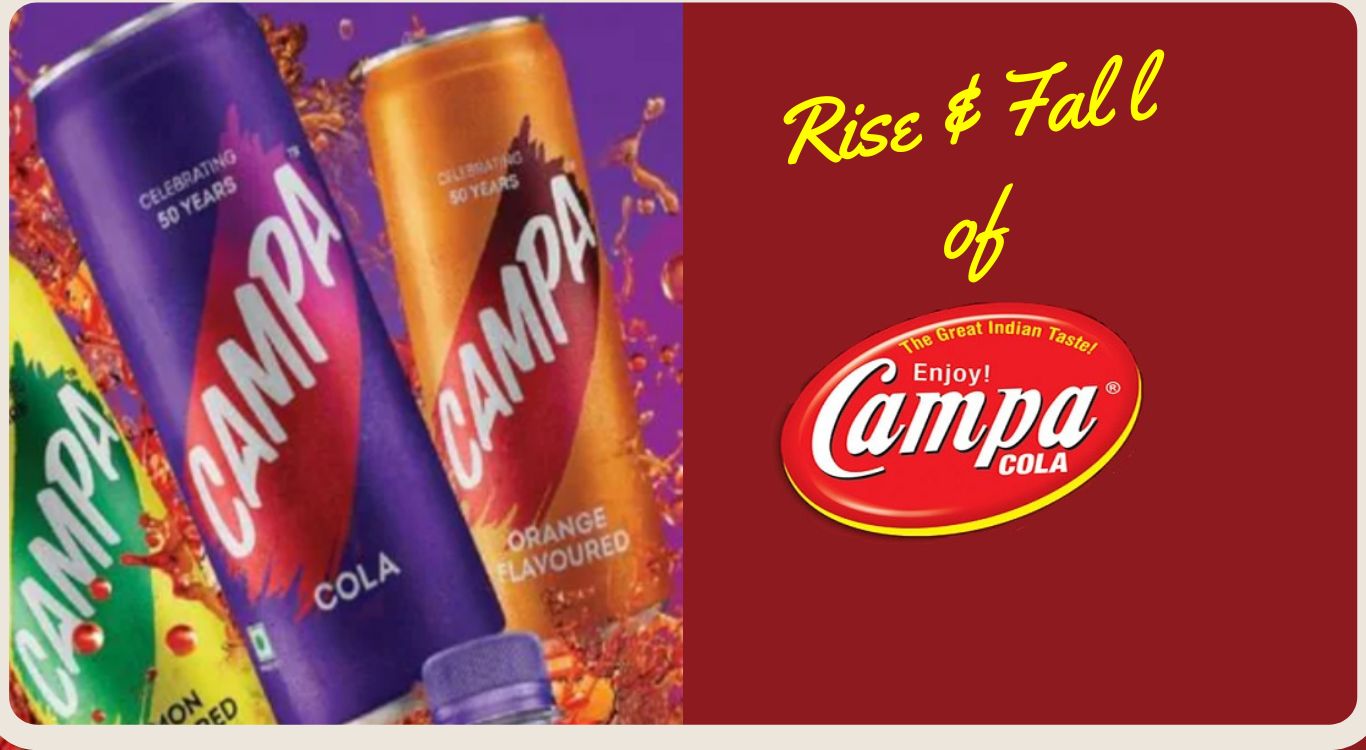Campa Cola Business Model, Success Story & Case Study of the former Sarkari Cola
Did you know? It was Campa Cola that promised “the great Indian taste” to India. Back in the ’80s, Campa Cola was young India’s first drink choice. It had occupied a good area of customer base in the Indian market. But, that did not stay for long and soon the downfall of Campa Cola had begun. Now Campa Cola franchise are being offered and company is being revamped.
Campa Cola Revamped by Reliance Industries
Campa Cola recently became an internet sensation when the CEO of Reliance Industries announced the re-launch of Campa Cola. Yes, you heard it right, Reliance will bring back this 50-year-old iconic drink focusing on its old taste but, with a new bottle structure.
Many of us know the business journey of Campa Cola did not go well. It was one of India’s favorite soft drinks once. But, that scenario is going to change and all the credit for such goes to Reliance Industries. Reliance Industries acquired Campa Cola last year for Rs 22 crore deal. They are currently planning to launch the iconic carbonated drink as “contemporized for a new-age India”, in three different flavors.
Campa Cola Case Study
During its initial days, Campa Cola used to sell soft drinks in four different flavors but, Reliance is planning to launch three of them. These flavors are Campa Cola, Campa Orange, and Campa Lemon. Reliance Industries have also revealed that all of these flavors will start rolling out in Andhra Pradesh and Telangana.
In an interview, Reliance revealed that the revamp of this brand is in the line with the company’s strategy to promote homegrown Indian brands. Reliance is doing this not only for the brand’s rich past or heritage but also for the customers who were a fan of the company’s unique tastes and flavors.
Without a doubt, we can say the revamp of this brand along with its products will bring joy and happiness to the old customers. People during the 80s will surely remember the old and traditional advertisements that Campa Cola used. We did see a 15-year-old Salman Khan among them- cavorting on a boat while gulping Campa Cola.
Campa Cola Initial Days in India
We could say Campa-Cola was lucky enough to make its presence in the Indian market. Reliance’s relaunch of Campa-Cola products will include the same products including its taste. During Campa-Cola’s initial days, it became a household name only because of its products.
Within a few months and years of its establishment, Campa-Cola became the market leader in the soft drink segment. It was Pure Drinks Group, a Mumbai-based beverages manufacturer that launched Campa-Cola into the Indian market. Before this spectacular launch, there is an interesting story of how Campa-Cola was established, which we will discuss later in the article.
Campa-Cola was not only famous due to its products and their taste but, due to its advertisements as well. Campa-Cola heavily advertised its products in the market and in the most innovative way possible. One of the advertisements introduced by Campa-Cola involved India’s most popular film star, Salman Khan. It was in 1982, when the advertisement filmmaker and founder of Kailash Picture Company, Kailash Surendranath were approached by Chaitra Advertising to create an advertisement campaign for Campa Cola.
We saw beautiful deep sea footage in the famous Campa-Cola advertisement. The advertisement campaigns held for and by Campa-Cola made them famous. The brand’s slogan was, ‘The Great Indian Taste’ and it was a big hit at the time when it appealed to the nationalist sentiment. So, this was how Campa-Cola ruled the Indian soft drink market during its initial days.
Campa Cola Initial Logo

Founders and How it Started?
There is a rich history when it comes to Campa Cola. Let us go back to 1949 when Coca-Cola was introduced in India under Pure Drinks Group. It was Pure Drinks Group that agreed to sell Coca-Cola products in India during that time. From 1949-1976, The Coca-Cola Company was doing quite well in the Indian market.
They captured a good market area within these years and were earning huge revenue. Later, in 1977 during the rule of Morarji Desai’s government Pepsi-Cola and Coca-Cola had to exit India due to some particular rules and regulations.
Now, while Coca-Cola was exiting India, Pure Drinks Group launched Campa-Cola to replace world-renowned Coca-Cola products. Pure Drinks Group did this to fill the market gap that Coca-Cola products had taken. From 1977 to 1992 India did not have any Coca-Cola products, instead, there were Limca, Gold Spot, and Campa Cola.
Along with Campa-Cola, Limca and Gold Spot were some of the soft drink brands that dominated the soft drink market in India. During this tenure, Campa’s portfolio included the three iconic flavors and they are Campa Lemon, Campa Cola, and Campa Orange.
Campa-Cola did dominate the Indian soft drink market till 1992 but, in 1990 Pepsi again entered India through a joint venture. Later in 1993, Coca-Cola entered India with the liberalization policy which fizzled out India’s homegrown soft drink brands including Campa-Cola.
Some of the soft drink brands that were ruling the Indian market, such as Limca and Gold Spot were acquired by The Coca-Cola Company. As a fact, Limca and Gold Spot were a part of Parle Groups. Moreover, this was how Campa-Cola was founded in the Indian market.
Campa-Cola Business Model in the 1970s
Campa was a household name for a short time still, the business model was as smooth as anybody else. It was smooth only because Pure Drinks Group knew all the processes to conduct business.
Charanjit Singh, the promoter of Pure Drinks Group was making Coca-Cola at its plant. He knew that all the workers would be without jobs because of the government’s decision. Since he was already fluent with the company’s facilities, he launched Campa-Cola’s orange-flavored drink. So, the product was being manufactured at Pure Drink Group’s manufacturing unit and was being distributed through retailers to the market.
Campa-Cola gained more market share when one of its competitors, Double Seven introduced a product whose taste did not find much favor with the consumers.
Campa-Cola Success Story: Rise of Campa-Cola
Campa was surely a lucky brand to be introduced during the era when all the top market players exited India. The Coca-Cola Company and Pepsi played a major role when they brought the unique taste of soft drinks to Indian consumers. Consumers developed and appreciated the taste brought by these big players in the Indian market.
When Coca-Cola and Pepsi exited India, Pure Drinks Group knew the market gap. Without Coca-Cola and Pepsi, surely no other individual brand would have seen a successful journey other than Campa-Cola. Campa exactly knew what taste and preference would be loved by Indian consumers. So, the promoters and directors of the manufacturing unit bought a homegrown product offering the taste just like the big players who exited the market.
Other than that, during Campa-Cola’s era, the brand spent a lot of resources on its advertisement campaigns. Consumers loved the brand’s catchline, ‘The Great Indian Taste’ because it was aligned with the national sentiments during that era. Interestingly, Limca, Thumps Up, and Gold Spot also used the same catchline for their products. This is the reason why these brands along with Campa-Cola was doing so well in the Indian market.
Failure of Campa-Cola
The entry of Campa-Cola was because of its competitors and the failure of Campa-Cola was also because of its competitors. The big players such as Pepsi and Coca-Cola had always dominated other soft-drink brands in India. So, the re-entry of Coca-Cola 1990 into the domestic market owing to the liberalization policy became a bad dream for Campa-Cola.
One of the biggest reasons why Campa-Cola failed was because it could not compete with the advertisements and marketing strategies spent by other big players. This was the only major reason why Campa-Cola failed in the Indian market.
How Campa-Cola Collapsed Later?
Pepsi and Coca-Cola company gained a huge foothold in the Indian market in 1989 and 1991. This happened when former Prime Minister Manmohan Singh made economic reforms. This hugely affected Campa-Cola into its existing business.
This was when Campa-Cola started losing its customer base in its homeland. Coca-Cola and Pepsi started spending huge resources on their advertisements. They began to overtake Campa-Cola with an aggressive advertisement policy. Almost every Delhi bottling plant along with offices was closed down in 2001 and 2009.
Campa-Cola Future with Reliance
We do have to agree that people in the 70s and 80s have lots of memories with Campa-Cola. Limca and Thumps Up might be an Indian-originated brand but, they have been acquired by The Coca-Cola Company so they cannot make a home return.
After Reliance Industries bought Campa-Cola in 2022 we know something new and interesting is going to happen. Today, Reliance is selling Campa-Cola’s exclusive products through JioMart and Reliance Stores. They are doing this since the middle of 2022 and are willing to expand more in the upcoming future.
As of now, Reliance has given a renewed focus on the FMCG sector. Reliance is just trying to bring up homegrown Indian brands so that it can compete with the big players in India.
Will Campa-Cola be able to compete with Coca-Cola?
Reliance Retail Ventures bought a great opportunity for Campa-Cole to compete with Coca-Cola products. Reliance is the market leader in many aspects and surely has serious plans on competing with Coca-Cola products which have been in the Indian market for a long time.
Reliance has added fizz to desi Campa so that it becomes unique in the market. Other than that, Reliance is focusing quite a lot on the price factor of the products. This summer some sources have revealed that PepsiCo and Coca-Cola along with other companies will have an aggressive price war. The teams from PepsiCo and The Coca-Cola Company have stepped up and are offering discounts, consumer promotions, and local marketing spending.
As of today, Campa-Cola is surely giving good competition to Coca-Cola. Reliance being a good market capturer will surely be able to compete with any top player in the Indian market.
